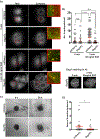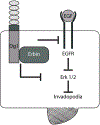Desmoglein 1 Regulates Invadopodia by Suppressing EGFR/Erk Signaling in an Erbin-Dependent Manner
- PMID: 30655320
- PMCID: PMC6581214
- DOI: 10.1158/1541-7786.MCR-18-0048
Desmoglein 1 Regulates Invadopodia by Suppressing EGFR/Erk Signaling in an Erbin-Dependent Manner
Abstract
Loss of the desmosomal cell-cell adhesion molecule, Desmoglein 1 (Dsg1), has been reported as an indicator of poor prognosis in head and neck squamous cell carcinomas (HNSCC) overexpressing epidermal growth factor receptor (EGFR). It has been well established that EGFR signaling promotes the formation of invadopodia, actin-based protrusions formed by cancer cells to facilitate invasion and metastasis, by activating pathways leading to actin polymerization and ultimately matrix degradation. We previously showed that Dsg1 downregulates EGFR/Erk signaling by interacting with the ErbB2-binding protein Erbin (ErbB2 Interacting Protein) to promote keratinocyte differentiation. Here, we provide evidence that restoring Dsg1 expression in cells derived from HNSCC suppresses invasion by decreasing the number of invadopodia and matrix degradation. Moreover, Dsg1 requires Erbin to downregulate EGFR/Erk signaling and to fully suppress invadopodia formation. Our findings indicate a novel role for Dsg1 in the regulation of invadopodia signaling and provide potential new targets for development of therapies to prevent invadopodia formation and therefore cancer invasion and metastasis. IMPLICATIONS: Our work exposes a new pathway by which a desmosomal cadherin called Dsg1, which is lost early in head and neck cancer progression, suppresses cancer cell invadopodia formation by scaffolding ErbB2 Interacting Protein and consequent attenuation of EGF/Erk signaling.
©2019 American Association for Cancer Research.
Conflict of interest statement
The authors declare no potential conflicts of interest.
Figures






Similar articles
-
Desmoglein-1/Erbin interaction suppresses ERK activation to support epidermal differentiation.J Clin Invest. 2013 Apr;123(4):1556-70. doi: 10.1172/JCI65220. Epub 2013 Mar 25. J Clin Invest. 2013. PMID: 23524970 Free PMC article.
-
DCLK1-mediated regulation of invadopodia dynamics and matrix metalloproteinase trafficking drives invasive progression in head and neck squamous cell carcinoma.Mol Cancer. 2025 Feb 24;24(1):50. doi: 10.1186/s12943-025-02264-3. Mol Cancer. 2025. PMID: 39994636 Free PMC article.
-
Ableson kinases negatively regulate invadopodia function and invasion in head and neck squamous cell carcinoma by inhibiting an HB-EGF autocrine loop.Oncogene. 2013 Oct;32(40):4766-77. doi: 10.1038/onc.2012.513. Epub 2012 Nov 12. Oncogene. 2013. PMID: 23146907 Free PMC article.
-
Epidermal growth factor receptor (EGFR) and squamous cell carcinoma of the skin: molecular bases for EGFR-targeted therapy.Pathol Res Pract. 2011 Jun 15;207(6):337-42. doi: 10.1016/j.prp.2011.03.002. Epub 2011 Apr 29. Pathol Res Pract. 2011. PMID: 21531084 Review.
-
Targeting invadopodia for blocking breast cancer metastasis.Drug Resist Updat. 2018 Jul;39:1-17. doi: 10.1016/j.drup.2018.05.002. Epub 2018 May 17. Drug Resist Updat. 2018. PMID: 30075834 Review.
Cited by
-
Autoantibody-Specific Signalling in Pemphigus.Front Med (Lausanne). 2021 Aug 9;8:701809. doi: 10.3389/fmed.2021.701809. eCollection 2021. Front Med (Lausanne). 2021. PMID: 34434944 Free PMC article. Review.
-
Cell adhesion in cancer: Beyond the migration of single cells.J Biol Chem. 2020 Feb 21;295(8):2495-2505. doi: 10.1074/jbc.REV119.007759. Epub 2020 Jan 14. J Biol Chem. 2020. PMID: 31937589 Free PMC article. Review.
-
Desmosomal Cadherins in Health and Disease.Annu Rev Pathol. 2022 Jan 24;17:47-72. doi: 10.1146/annurev-pathol-042320-092912. Epub 2021 Aug 23. Annu Rev Pathol. 2022. PMID: 34425055 Free PMC article. Review.
-
Cell Adhesion Molecules as Modulators of the Epidermal Growth Factor Receptor.Cells. 2024 Nov 19;13(22):1919. doi: 10.3390/cells13221919. Cells. 2024. PMID: 39594667 Free PMC article. Review.
-
Paradoxical Roles of Desmosomal Components in Head and Neck Cancer.Biomolecules. 2021 Jun 20;11(6):914. doi: 10.3390/biom11060914. Biomolecules. 2021. PMID: 34203070 Free PMC article. Review.
References
-
- Marur S, and Forastiere AA. Head and Neck Squamous Cell Carcinoma: Update on Epidemiology, Diagnosis, and Treatment. Mayo Clin. Proc 2016; 91, 386–396. - PubMed
-
- Curry JM, Sprandio J, Cognetti D, Luginbuhl A, Bar-ad V, Pribitkin E, et al. Tumor Microenvironment in Head and Neck Squamous Cell Carcinoma. Semin. Oncol 2014; 41, 217–234. - PubMed
Publication types
MeSH terms
Substances
Grants and funding
LinkOut - more resources
Full Text Sources
Medical
Research Materials
Miscellaneous

